Reptiles and Amphibians of the San Francisco Bay Area

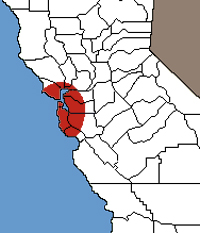
Area covered here is marked in red.

These are the native and well-established non-native herps that inhabit the Bay Area, which for our purposes includes the land surrounding most of the San Francisco Bay including parts of Alameda, Contra Costa, San Francisco, San Mateo, Santa Clara, Santa Cruz, Solano, Napa and Marin counties. In the East Bay, the range covered extends out to around Livermore, or before the mountains. As you go east into where the Coast Range meets the Central Valley, several new species occur which are not covered here. |
|||||||||
|
|||||||||
| Snakes | |||||||||
Most snakes in the San Francisco Bay Area are active during warm and sunny weather, typically from late February through October, and remain underground at other times. |
|||||||||
| Pacific Gophersnake Pituophis catenifer catenifer |
|||||||||
| Not Dangerous to Humans | |||||||||
Video |
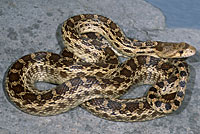 |
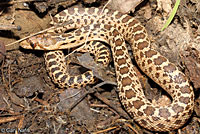 |
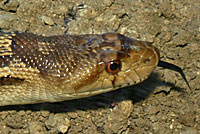 |
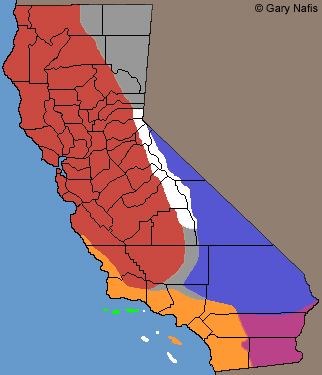 Range shown in Red |
|||||
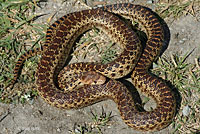 |
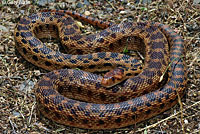 |
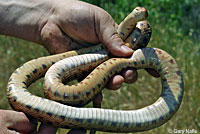 |
|||||||
| Adults are typically 4 to 5 ft. long. Hatchlings are around 15 inches long. A large, thick bodied, slow-moving snake with a head slightly wider than the neck and large rough scales. Brown or tan with dark markings on the back and often rusty coloring on the back and head. |
Diurnal. Nocturnal on hot nights. Probably the most commonly seen snake in our area. Found in many habitats - grassland, chaparral, agricultural, riparian, woodlands, from sea level to the mountains. |
Eats mostly small mammals, birds, eggs. Females lay eggs June to August. Young hatch August to October. Often confused with rattlesnakes, but the tail is long and thin with no rattle. See here. |
|||||||
| Western Yellow-bellied Racer Coluber constrictor mormon |
|||||||||
| Not Dangerous to Humans | |||||||||
Videos |
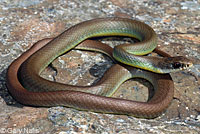 |
 |
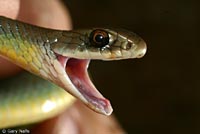 |
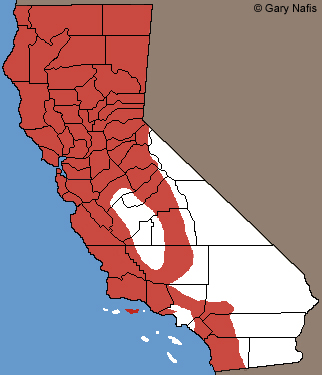 Range shown in Red |
|||||
| Adults have no pattern | Juveniles have a brown blotched pattern | ||||||||
| Adults are typically 2 to 3 feet long. Hatchlings are 8 to 11 inches long. A long slender fast-moving snake with a large head and eyes and a long thin tail. Brown, greenish, or grey without markings. Young are brown with dark brown markings. |
Diurnal. Common. Found in open sunny areas including meadows, grassland, chaparral, open woodlands, and riparian areas, in arid and moist areas. Not found at very high elevations. |
Eats lizards, small mammals, birds, snakes, eggs, frogs, and insects. Females lay eggs in early summer. Young hatch in late summer and fall. |
|||||||
| California Kingsnake Lampropeltis californiae (formerly Lampropeltis getula californiae) |
|||||||||
| Not Dangerous to Humans | |||||||||
Video |
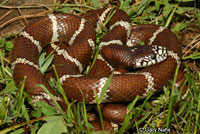 |
 |
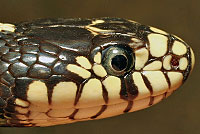 |
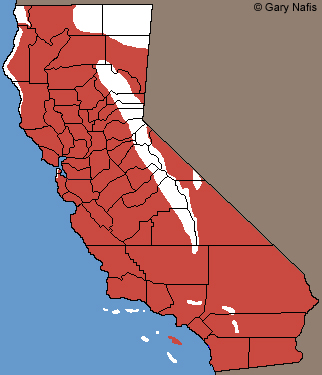 Range shown in Red |
|||||
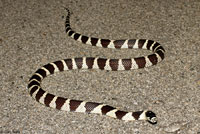 |
 |
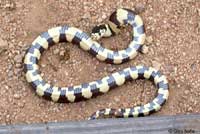 |
|||||||
| Adults are typically 3 to 4 ft. long. A large, thick bodied, slow-moving snake with a head slightly wider than the neck and smooth scales. Color is black or brown with light bands circling the body. The underside is light in color. The dark bands continue around onto the underside. |
Diurnal and Nocturnal. Common. Found in a wide range of habitats: forest, woodland, chaparral, grassland, wetlands, agricultural land, deserts, brushy suburban areas, from sea level to mountains. |
Eats small mammals, lizards, snakes (including rattlesnakes) eggs, frogs, birds, and large invertebrates. Females lay eggs May to August. |
|||||||
| Northern Rubber Boa Charina bottae |
|||||||||
| Not Dangerous to Humans | |||||||||
Video |
 |
 |
 |
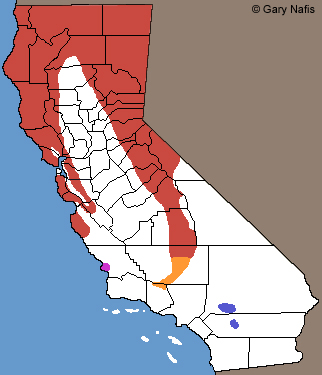 Range shown in Red |
|||||
| Adults are brown, tan, or olive | Some juveniles are orange or pink © Jared Heald |
||||||||
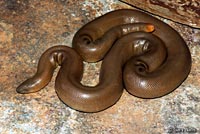 |
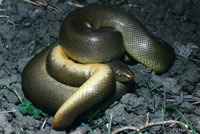 |
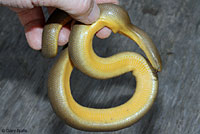 |
|||||||
| Adults are usually 15 to 25 inches long. A small stout slow-moving snake with small smooth scales, wrinkled skin, and a short blunt tail. Color is a solid light brown, dark brown, pinkish, tan, or olive green. Occasionally there is dark mottling, and the end of the tail is sometimes orange or yellow. Young are sometimes orange or pink. |
Nocturnal and crepuscular. Common but secretive. Found in grassland, meadows, chaparral, woodland, deciduous and coniferous forest. |
Eats small mammals, birds, salamanders, lizards, snakes, and possibly frogs. Young are born live some time between August to November. |
|||||||
| California Mountain Kingsnake Lampropeltis zonata |
|||||||||
| Not Dangerous to Humans | |||||||||
Video of similar species |
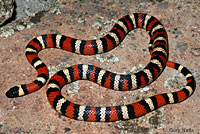 |
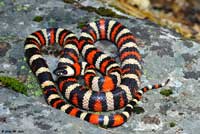 |
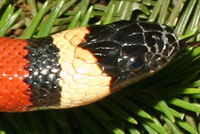 |
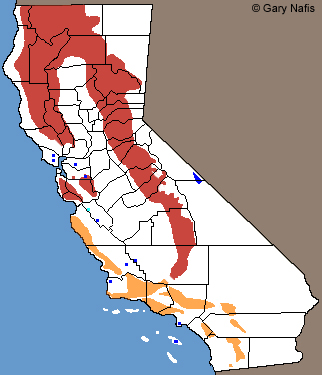 Range shown in red |
|||||
| Adults are tyically 24 to 30 inches long. Hatchlings are 7 to 11 inches long. A slender snake with a rounded body and almost no neck. Black, red, and white or yellowish bands circle the body. Often some of the black bands cross over the top of the red bands. |
Diurnal. Nocturnal during hot weather. Secretive and not commonly seen. Found in coniferous forest, mixed woodlands, chaparral, manzanita, coastal sage scrub, typically around rock outcops near streams in the mountains. |
Eats lizards, small mammals, birds, amphibians, and sometimes snakes. Females lay eggs June and July which hatch August and September.
|
|||||||
| California Nightsnake Hypsiglena ochrorhyncha nuchalata (formerly Hypsliglena torquata nuchalata) |
|||||||||
| Not Dangerous to Humans | |||||||||
Video |
 |
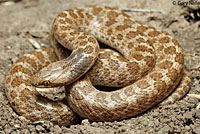 |
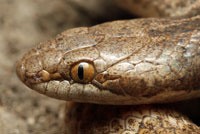 |
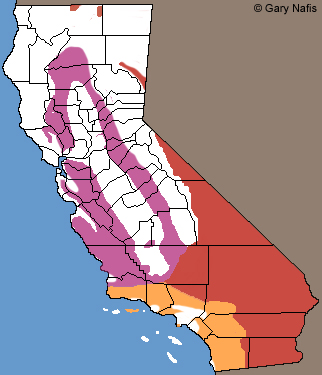 Range shown in Purple |
|||||
| Most adults are about a foot long, rarely over 16 inches. Hatchlings are abpit 7 inches long. A small slender snake with a narrow head and smooth scales. Light gray, light brown, beige, tan, or cream in color with dark brown or gray blotches on the backs and sides and a dark band on the neck and another through the eyes. |
Nocturnal. Secretive and not often seen. Found in a variety of habitats, including chaparral, suburban lots and gardens, meadows and grassland, from sea level into the mountains. |
Eats mostly lizards and their eggs, plus small snakes, amphibians, and other small vertebrates. Females lay eggs from April to September. |
|||||||
| Sharp-tailed Snake Contia tenuis |
|||||||||
| Not Dangerous to Humans | |||||||||
Video |
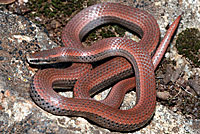 |
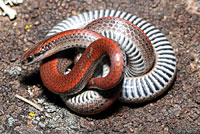 |
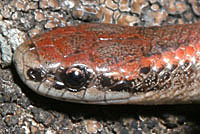 |
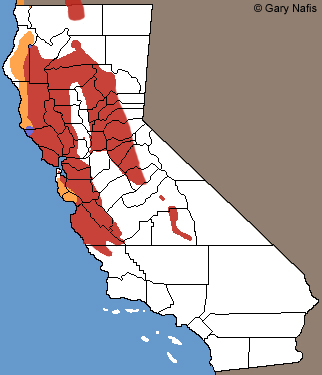 Range shown in Red |
|||||
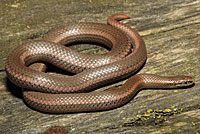 |
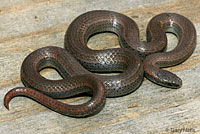 |
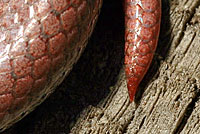 |
|||||||
| Adults are typically 8 to 12 inches long. Hatchlings are 3 inches long. A small thin snake with a flattened head. Gray or rusty red in color. The head is typically reddish on top, light gray on the sides with a black stripe through each eye. The underside is pale with alternating black crossbars. Sometimes there is a yellow or red stripe on the upper sides. Juveniles are red with dark lines on the side. The tail has a sharp point on the end. |
Common but secretive and rarely seen crawling. Found in moist areas in woodland, forests, grassland, chaparral, often near streams or water. Typically found underneath wood or rocks or leaf litter in moist areas, often in suburban yards. |
Eats slugs and their eggs and small salamanders. Females lay eggs in June or July which hatch in fall. |
|||||||
| Forest Sharp-tailed Snake Contia longicauda |
|||||||||
| Not Dangerous to Humans | |||||||||
Video of similar species |
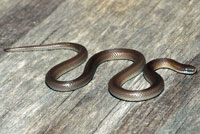 |
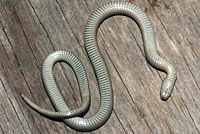 |
 |
 Range shown in Orange |
|||||
| Adults average 11 inches in length. Hatchlings are 3 inches long. A small snake with a flat head. Gray or rusty red in color. The head is typically reddish on top, light gray on the sides with a black stripe through each eye. The underside is pale with alternating black crossbars. Sometimes there is a yellow or red stripe on the upper sides. Juveniles are red with dark lines on the side. |
Common but secretive and rarely seen crawling. Found in moist areas in woodland, forests, grassland, chaparral, often near streams or water. Typically found underneath wood or rocks or leaf litter in moist areas, often in suburban yards. |
Eats slugs and their eggs and small salamanders. Females lay eggs in June or July which hatch in fall. Secretive. Usually found hiding underneath objects. Found only on the Peninsula. |
|||||||
| Pacific Ring-necked Snake Diadophis punctatus amabilis |
|||||||||
| Not Dangerous to Humans | |||||||||
Video |
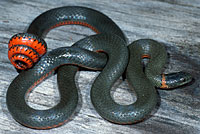 |
 |
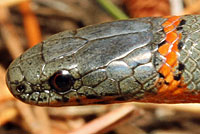 |
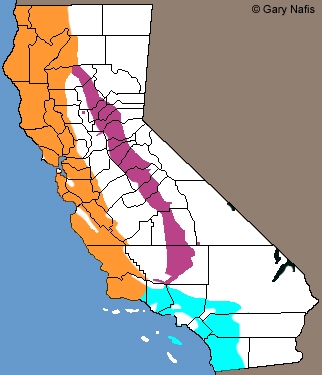 Range shown in Red |
|||||
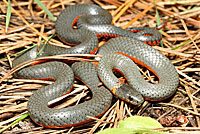 |
 |
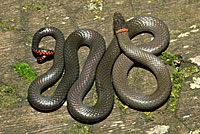 |
|||||||
| Adults grow up to 34 inches long. A small thin snake with smooth scales. Color is gray, dark olive, or black with a narrow orange band around the neck. The underside is bright yellow or orange or speckled with black markings. This underside is often displayed in a coil when a snake is feeling threatened. |
Diurnal and nocturnal. Common but secretive and rarely seen crawling. Found in moist habitats including wet meadows, rocky hillsides, gardens, farmlands, grassland, chaparral, mixed coniferous forest and woodlands. |
Eats small salamanders, tadpoles, frogs, snakes, lizards, worms, slugs, and insects. Females lay eggs in the summer which hatch mostly in the fall. |
|||||||
| California Striped Racer Masticophis lateralis lateralis (Also Coluber lateralis lateralis) |
|||||||||
| Not Dangerous to Humans | |||||||||
Video |
 |
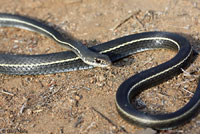 |
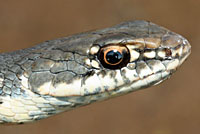 |
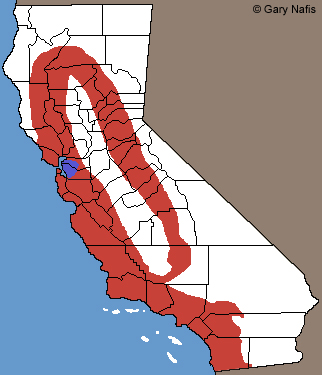 Range shown in Red |
|||||
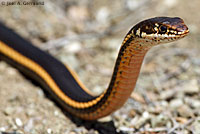 |
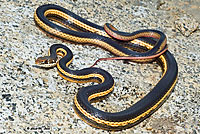 |
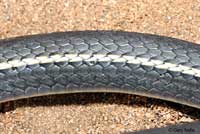 |
|||||||
| © Joel A. Germond | © Chad M. Lane | The light side stripe is thin, often only two half scales wide | |||||||
| Adults are typically 3 to 4 feet long. A slender very fast-moving snake with large head and eyes and smooth scales. Dark brown or grey with one pale stripe on each side. No stripe on the back. |
Diurnal and conspicuous. Common. Found in a variety of open areas including canyons, rocky hillsides, chaparral, open woodlands, pond edges and stream courses from sea level to the mountains. |
Eats small mammals, lizards, frogs, and snakes Females lay eggs in late spring and early summer. Eggs hatch in late summer and fall. Found in the West Bay, South Bay, and North Bay. |
|||||||
| Alameda Striped Racer Masticophis lateralis euryxanthus (Also Coluber lateralis euryxanthus) |
|||||||||
| Not Dangerous to Humans | |||||||||
Video of similar subspecies |
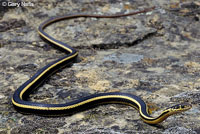 |
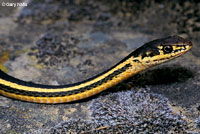 |
 |
 Range shown in Blue |
|||||
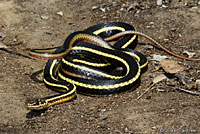 |
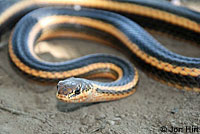 |
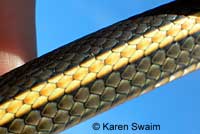 |
|||||||
| © Luke Talltree | © Jon Hirt | The light side stripe is usually two half scales and one full scale wide. © Karen Swaim. |
|||||||
| Adults are typically 3 to 4 feet long. Hatchlings are about 13 inches long. A slender fast-moving snake with a long thin tail and a broad elongated head. Dark brown or black with a wide orange stripe on each side. No stripe on the back. |
Diurnal. Found in open areas in chaparral, open woodlands, rocky hillsides and stream courses. Found only in the East Bay. Threatened due to disappearing habitat. |
Eats lizards, small rodents, birds, frogs, salamanders, and small snakes. Females lay eggs in late spring and early summer which hatch in late summer and early fall. |
|||||||
| |
|||||||||
| Coast Gartersnake Thamnophis elegans terrestris |
|||||||||
| Not Dangerous to Humans | |||||||||
Video |
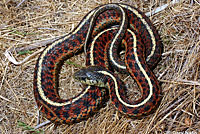 |
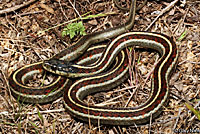 |
 |
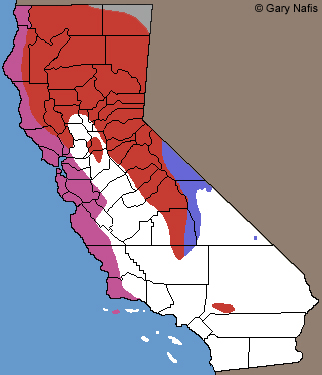 Range shown in Purple |
|||||
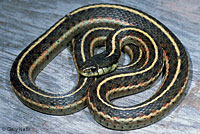 |
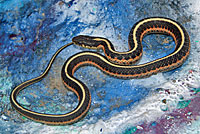 |
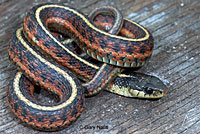 |
|||||||
| 18 to 43 inches long. A slender snake with a head barely wider than the neck and keeled scales. Variable in appearance. Color is brown, gray, or black, with a ligh-colored stripe on each side and one on the back. Typically there are red and black markings on the sides in-between the stripes. Some snakes have little or no red, others are amlost entirely red on the sides or have red side stripes. |
Diurnal. Common in wetland areas. Common and conspicuous. Abundant in some areas. Found in grassland, mixed woodland, forest, dunes, and brushland. Most likely to be found near water. |
Eats a wide variety of prey, including amphibians, amphibian larvae, fish, birds, small rodents, lizards, snakes, worms, leeches, slugs, and snails. Young are born live July to September. |
|||||||
| Santa Cruz Gartersnake Thamnophis atratus atratus |
|||||||||
| Not Dangerous to Humans | |||||||||
Video |
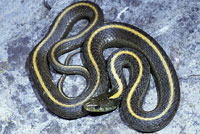 |
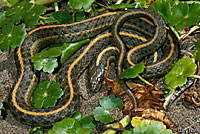 |
 |
 Range shown in Red and Gray |
|||||
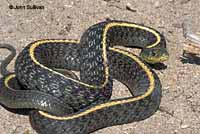 |
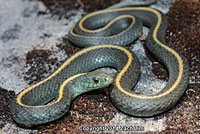 |
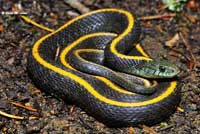 |
|||||||
| © John Sullivan | © Zachary Lim | © Chad M. Lane | |||||||
| Most adults encountered are 18 to 28 inches long. Newborns are 7 to 10 inches long. A slender snake with a head barely wider than the neck and keeled scales. Color is gray, brown, or black, with a wide yellow or orange stripe on the back and no stripes on the sides. |
Diurnal. Common in many wetland areas. Very aquatic, usually found in or near water. Found in creeks, streams, lakes, ponds, coast driftwood, in woodland, brush, and grassland. |
Eats amphibians and their larvae and small fish. Young are born live late summer to early fall. Found only in the West Bay. Snakes in the North Bay are a cross between this snake and the Diablo Range Gartersnake. |
|||||||
| Diablo Range Gartersnake Thamnophis atratus zaxanthus |
|||||||||
| Not Dangerous to Humans | |||||||||
Video |
 |
 |
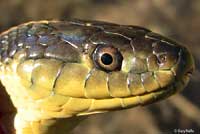 |
 Range shown in light Blue |
|||||
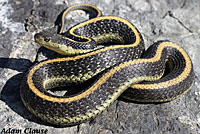 |
 |
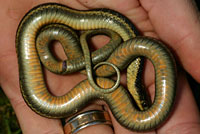 |
|||||||
| © Adam Clause |
|||||||||
| Most adults encountered are 18 to 28 inches long. Newborns are 7 to 10 inches long. A slender snake with a head barely wider than the neck and keeled scales. Color is gray, brown, or black, with a wide yellow or orange stripe on the back and no stripes on the sides. |
Diurnal. Very aquatic, usually found in or near water. Found in creeks, streams, lakes, ponds, coast driftwood, in woodland, brush, and grassland. |
Eats amphibians and their larvae and small fish. Young are born live late summer to early fall. Found only in the East Bay. Snakes in the North Bay are a cross between this snake and the Santa Cruz Gartersnake. |
|||||||
| California Red-sided Gartersnake Thamnophis sirtalis infernalis |
|||||||||
| Not Dangerous to Humans | |||||||||
Video |
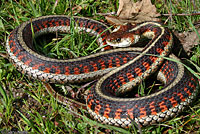 |
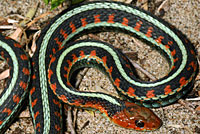 |
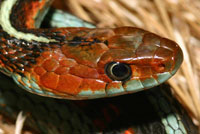 |
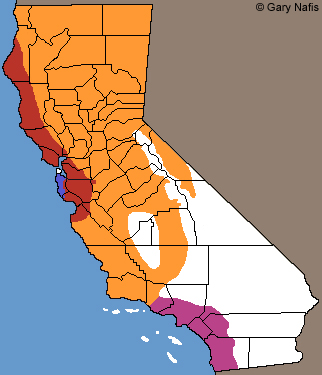 Range shown in Red |
|||||
 |
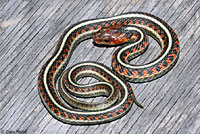 |
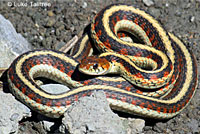 |
|||||||
| © Mike Spencer | Juvenile | © Luke Talltree | |||||||
| Adults are 15 to 55 inches long, averaging 36 inches. A slender snake with a slight neck, large eyes, and large keeled scales. Color is dark olive to black, with light stripes on the back and on each side. The head is red and there are red markings on the sides between the stripes. Stripes are blue on some snakes in the north bay. |
Diurnal. Common in some areas. Found in a variety of habitats, including grasslands, chaparral, farmland, forests, and mixed woodlands. In our area this snake appears to be restricted to marsh and upland habitats near permanent water with riparian vegetation. |
Eats amphibians, tadpoles, fish, birds, eggs, small mammals, reptiles, earthworms, slugs, and leeches. Able to eat poisonous newts. Young are born live from spring to fall. |
|||||||
| San Francisco Gartersnake Thamnophis sirtalis tetrataenia |
|||||||||
| Not Dangerous to Humans | |||||||||
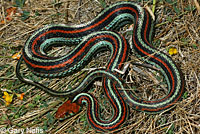 |
 |
 |
 Range shown in Dark Blue |
||||||
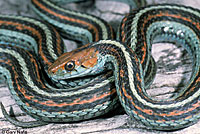 |
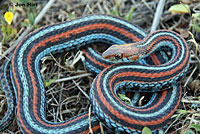 |
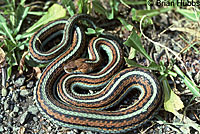 |
|||||||
| © Jon Hirt | © Brian Hubbs | ||||||||
| Adults are 15 to 55 inches long, averaging 36 inches. A slender snake with a slight neck, large eyes, and larged keeled scales. Color is dark olive to black, with light stripes on the back and on each side. The head is red and there are red markings on the sides between the stripes. Stripes are blue on some snakes in the north bay. |
Diurnal. Common in some areas, but threatened by loss of habitat. Found in grasslands, and wetlands near ponds, marshes and sloughs. |
Eats amphibians, tadpoles, fish, birds, eggs, small mammals, reptiles, earthworms, slugs, and leeches. Able to eat poisonous newts. Young are born live from spring to fall. Found only on the peninsula south of San Francisco north of Santa Cruz. |
|||||||
| Northern Pacific Rattlesnake Crotalus oreganus oreganus (formerly Crotalus viridis oreganus) |
|||||||||
| Venomous and Potentially Very Dangerous! | |||||||||
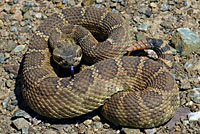 |
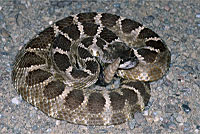 |
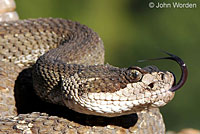 |
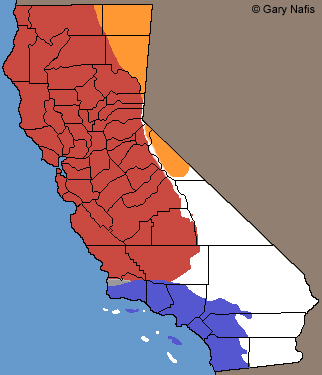 Range shown in Red and Gray |
||||||
Video |
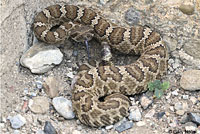 |
 |
 |
||||||
| Adults are typically 3 to 4 feet long. A heavy-bodied snake with a large triangular head and thin neck, and large keeled scales, and a tail tipped with a rattle that is shaken to produce a loud sound when the snake is feeling threatened. Young snakes have no rattle and cannot make a sound. Color is brown, olive, or black, with dark brown blotches outlined by light pigment on the back, and dark bars on the tail. |
Nocturnal and crepuscular in hot temperatures, and also diurnal during moderate temperatures. Common and conspicuous. Found in many habitats, including seaside dunes, scrub, grasslands, rocky hillsides, chaparral, open woodlands, and agricultural fields. No longer present in most developed areas. |
Eats small mammals, birds, lizards, snakes, and frogs. Young are born live from August to October. |
|||||||
| California Black-headed Snake Tantilla planiceps |
|||||||||
Video |
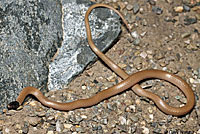 |
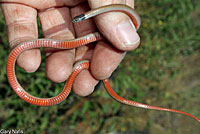 |
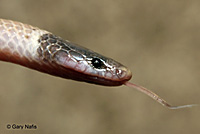 |
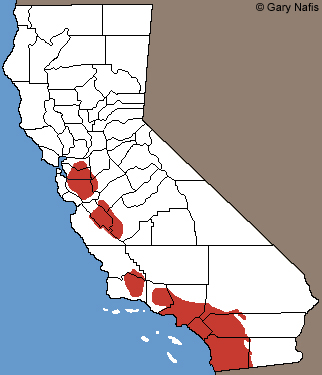 Range shown in Red |
|||||
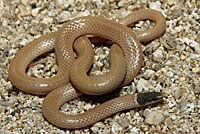 |
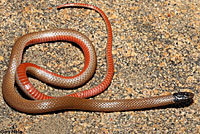 |
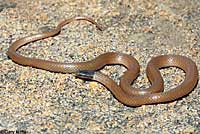 |
|||||||
| From 4 to 15 inches long. A very small, thin snake with a flat head and smooth scales. Color is brown or tan with no markings except for a dark brown or black head with a faint light collar between the body color and the dark head cap. The underside is reddish. |
Nocturnal. Uncommon and secretive. Rarely seen. Found in grassland, chaparral, and mixed woodlands. |
Eats millipedes, centipedes, and insects. Females lay eggs probably in spring, that hatch in summer. Found in the South Bay and East Bay. |
|||||||
| Long-nosed Snake Rhinocheilus lecontei |
|||||||||
| Not Dangerous to Humans | |||||||||
Video |
 |
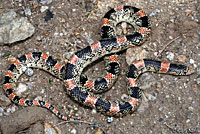 |
 |
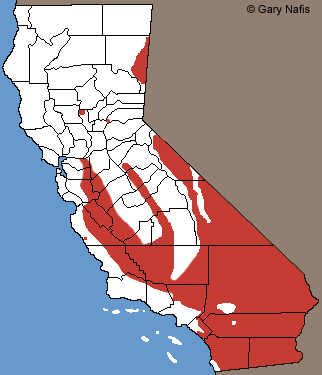 Range shown in Red |
|||||
| Adults are typically 16 to 30 inches long. Hatchlings are 7 to 11 inches long. A slender snake with smooth scales, only a faint neck and a head with a long pointed snout. Color is white with red and black saddles that do not entirely circle the body. Some snakes lack red coloring. |
Nocturnal and crepuscular but occasionally seen active in daylight. Uncommon in our area. Found in semi-arid grasslands, shrublands, and prairies. |
Eats mostly lizards and their eggs plus small snakes, small mammals, birds, and insects. Females lay eggs from June to August. Reported from Mt. Diablo. |
|||||||
| Lizards | |||||||||
Most lizards in the San Francisco Bay Area are active during warm and sunny weather, typically from late February through October, and remain underground at other times. They are most often seen during daylight sunning themselves on rocks, branches, fences, or walls, or running on the ground. |
|||||||||
| Coast Range Fence Lizard Sceloporus occidentalis bocourtii |
|||||||||
Video |
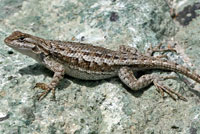 |
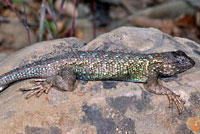 |
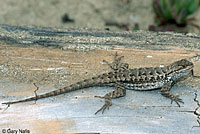 |
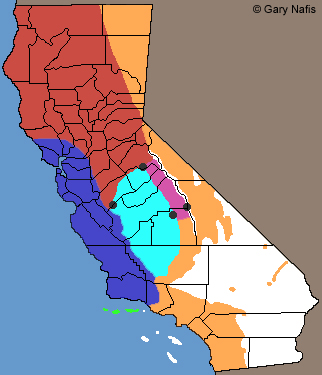 Range shown in Dark Blue |
|||||
 |
 |
 |
|||||||
| Adults are about 2.5 to 3.5 inches long, not including the tail. A fairly small lizard with keeled scales. Brown, gray, or black with dark blotches on the back. Sometimes light markings on the sides of the back form vague stripes. Recognizing differences between Fence Lizards and Sagebrush Lizards. |
Diurnal. The most common and conspicuous lizard in our area. Found in many different open, sunny areas, including woodlands, grasslands, chaparral, waterways, pond edges, houses and fences. |
Eats small bugs including crickets, spiders, ticks, scorpions, and even tiny lizards. Females lay eggs that hatch July to September, when very tiny lizards can be seen running around. Typically seen basking in the sun on fences, walls, branches, and rocks. |
|||||||
| San Francisco Alligator Lizard Elgaria coerulea coerulea |
|||||||||
Video |
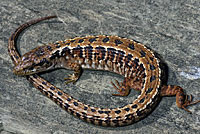 |
 |
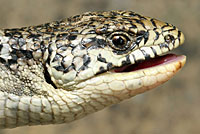 |
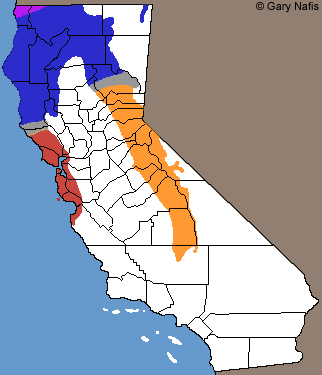 Range shown in Red and adjacent Gray |
|||||
 |
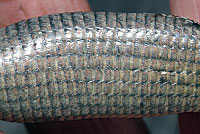 |
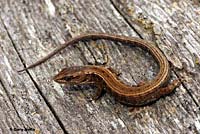 |
|||||||
| Dark lines on the belly run lengthwise in-between the rows of scales. |
Juveniles are copper-colored with fewer markings than are found on adults. | ||||||||
| Adults are about 3 to 6 inches long, not including the tail. An elongated lizard with large scales, a large head, short legs, and a fold along the bottoms of the sides. The tail can be very long, but often it is re-grown and stubby. Brown, gray, olive, or brown in color with a pattern of heavy dark blotches or irregular cross-bands edged with white spots on the back. Sometimes there is little or no pattern. Young are a coppery color with no pattern and are often mistaken for a small ground skink. Juveniles are long and thin and a copper color with no dark markings on the back. They are sometimes mistaken for a small ground skink (which does not occur in this area.) |
Diurnal. Common. Found in woodlands, forest, grassland, chaparral, coastal dunes, and marshes. Prefers wetter and cooler habitats than the California Alligator lizard. |
Eats a variety of small bugs, slugs, snails, and worms, and sometimes small lizards and mammals and birds and their eggs. Young are born live from June to September. Typically seen moving on the ground or basking on rocks or fallen branches. Moves with a snake-like undulating motion. |
|||||||
| Southern Alligator Lizard Elgaria multicarinata |
|||||||||
Video |
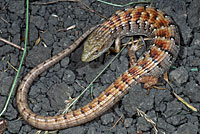 |
 |
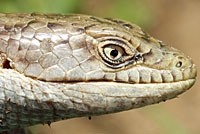 |
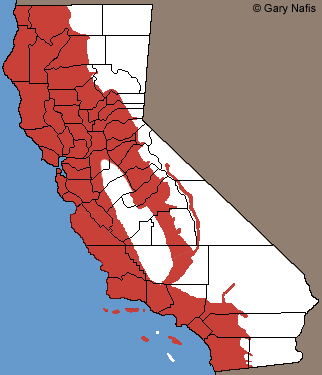 Range shown in Red |
|||||
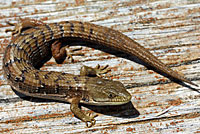 |
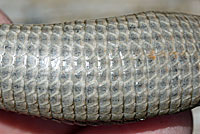 |
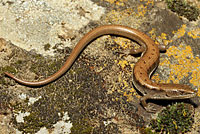 |
|||||||
| Dark lines on the belly run lengthwise through the middle of the scales. | Juveniles are copper-colored with fewer markings than are found on adults. | ||||||||
| Adults are about 3 to 7 inches long, not including the tail, and can be up to 16 inches long including the tail. An elongated lizard with large scales, a large head, short legs, and a fold along the bottoms of the sides. The tail can be very long, but often it is re-grown and stubby. Brown, grey, or yellowish above, often with orange or red coloring on the middle of the back. Usually there are dark bands on the back, sides, and tail. Juveniles are long and thin and a copper color with no dark markings on the back. They are sometimes mistaken for a small ground skink (which does not occur in this area.) |
Diurnal. Common. Found in grassland, open forest, chaparral, oak woodlands. Typically prefers drier areas than the San Francisco Alligator lizard. |
Eats a variety of small bugs, slugs, snails, and worms, and sometimes small lizards and mammals and birds and their eggs. Females lay eggs from May to July which hatch in late summer and early fall. Typically seen moving on the ground or basking on rocks or fallen branches. Moves with a snake-like undulating motion. |
|||||||
| Northern California Legless Lizard Anniella pulchra |
|||||||||
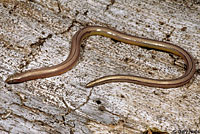 |
 |
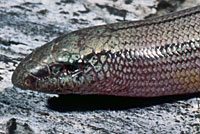 |
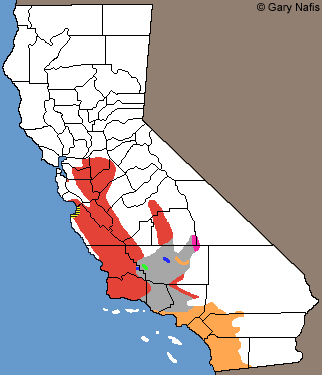 Range shown in Red Range shown in Red |
||||||
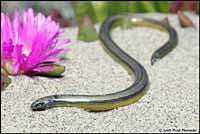 |
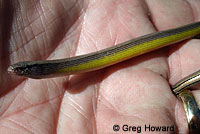 |
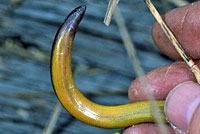 |
|||||||
| © Brad Alexander | © Greg Howard | Belly color is light, often bright yellow | |||||||
| Adults are about 5 to 7 inches long. A small slender lizard a shovel-shaped snout, smooth shiny scales, a blunt tail, and no legs. Often thought to be a small snake. Color varies from metallic silver, beige, dark brown, to black. Usually there is a dark line along the back and several thin stripes on the sides. |
Diurnal. Uncommon and secretive - rarely seen. Found in beach dunes, chaparral, mixed woodlands, sandy washes and stream terraces where there is moist warm loose soil with plant cover. |
Eats mostly insect larvae, beetles, termites, and spiders. Young are born live September to November. |
|||||||
| Coast Horned Lizard (Formerly Blainville's Horned Lizard) Phrynosoma blainvillii |
|||||||||
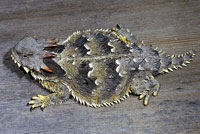 |
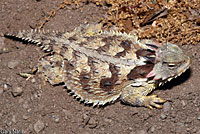 |
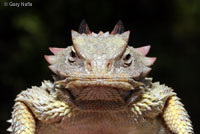 |
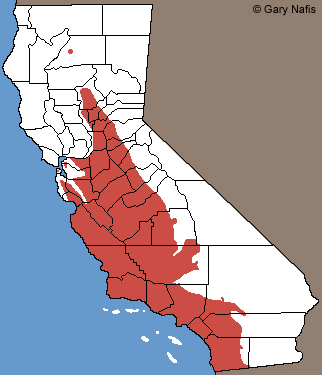 Range shown in Red |
||||||
| Adults are 2.5 to 4.5 inches long, not including the tail. A flat lizard with a very wide oval body, large pointed scales protruding from the body and the short flat tail, and very large pointed horns around the back of the head. Unlike any other lizard in our area. Brown, reddish, or yellowish with dark blotches on the back. |
Diurnal. Uncommon. Gone from much of its previous range due to loss of habitat and harvester ants. Found in areas with loose sandy soil and low vegetation, including grassland, forests, woodlands, and chaparral. |
Eats mostly large harvester ants plus the occasional spider, beetle, termite, fly, bee, or grasshopper. Females lay eggs from May to June which hatch from August to September. Typically seen in open spaces on the ground or running across a road, often around anthills or ant trails. |
|||||||
| Western Sagebrush Lizard Sceloporus graciosus gracilis |
|||||||||
Video |
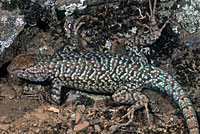 |
 |
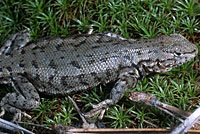 |
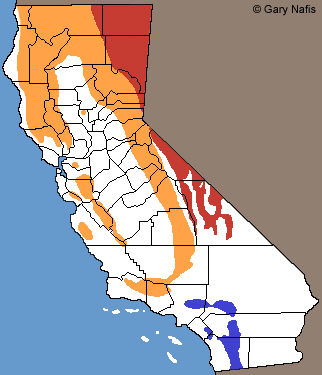 Range shown in Orange |
|||||
| Adults are about 2 to 3.5 inches long not including the tail. A small lizard with small keeled scales. Gray or brown in color with dark blotches or irregular bands on the body and tail and light stripes along the sides and upper sides at the edge of the back. There is usually a bar of black on the shoulder and rusty coloring on the armpits Males show blue coloring on the throat and sides of the belly. Females develop orange coloring on the throat and sides when they are gravid. |
Diurnal. Uncommon in our area. Found in areas grown with shrubs such as sagebrush, manzanita, and ceanothus, mostly in the mountains, where there are open areas that get a lot of sun. In our area, found at higher elevations of Mt. Diablo. |
Eats small bugs including ants, termites, grasshoppers, flies, spiders, and beetles. Females lay eggs from June to August that hatch in August and September. Typically seen basking on rocks or fallen branches or running on the ground inbetween rocks. Recognizing differences between Fence Lizards and Sagebrush Lizards. |
|||||||
| Western Side-blotched Lizard Uta stansburiana elegans |
|||||||||
Video |
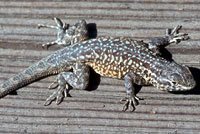 |
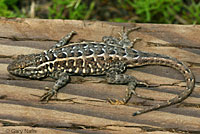 |
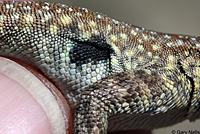 |
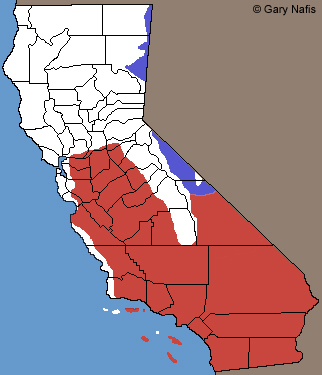 Range shown in Red |
|||||
| Adults are 1.5 to 2.5 inches long, not including the tail. A small lizard with smooth scales and a large dark marking, or blotch, on the sides, just behind the front limbs, which is not easily seen at a distance. Brown, black, gray, or yellowish in color with dark blotches, spots, and sometimes stripes, on the back. Sometimes there is a double row of dark wedge-shaped markings on the back, edged with white. Males have blue speckles on the back and can be very colorful. |
Diurnal. Common and conspicuous where they occur, but uncommon in our area where it is only found in the far East Bay and parts of the Santa Cruz Mountains. Found in open rocky areas with scattered vegetation, including sandy washes, vegetated with chaparral, scattered trees, grass, and shrubs. |
Eats small bugs including beetles, grasshoppers, ants, spiders, scorpions, and ticks. Females lay eggs from March to August which hatch from June to September. Typically seen basking on rocks or fallen branches. |
|||||||
| Variegated Skink Plestiodon gilberti cancellosus |
|||||||||
Video of similar subspecies |
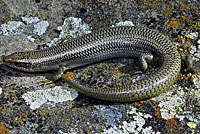 |
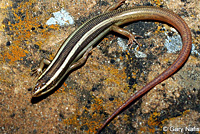 |
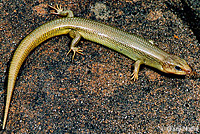 |
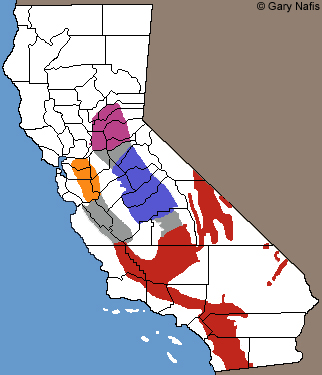 Range shown in Orange and adjacent Gray |
|||||
| Adults are 2.5 to 4.5 inches long, not including the tail. A large lizard with a heavy body, small head and thick neck, small legs, and smooth shiny scales. Olive or brown in color with some dark markings on the back that begin as dark stripes and fade with age. Older adults have a dark network of markings on the back. Young skinks have distinct light and dark stripes and a reddish or pink tail. Males develop red coloring on the throat during the breeding season. |
Diurnal. Secretive and not commonly seen moving around. Found in grassland, chaparral, woodlands, and pine forests, typically where there is moisture nearby. Found in the East Bay only. |
Eats small bugs. Females lay eggs in the summer. |
|||||||
| Northwestern (Skilton's) Skink Plestiodon skiltonianus skiltonianus |
|||||||||
Video |
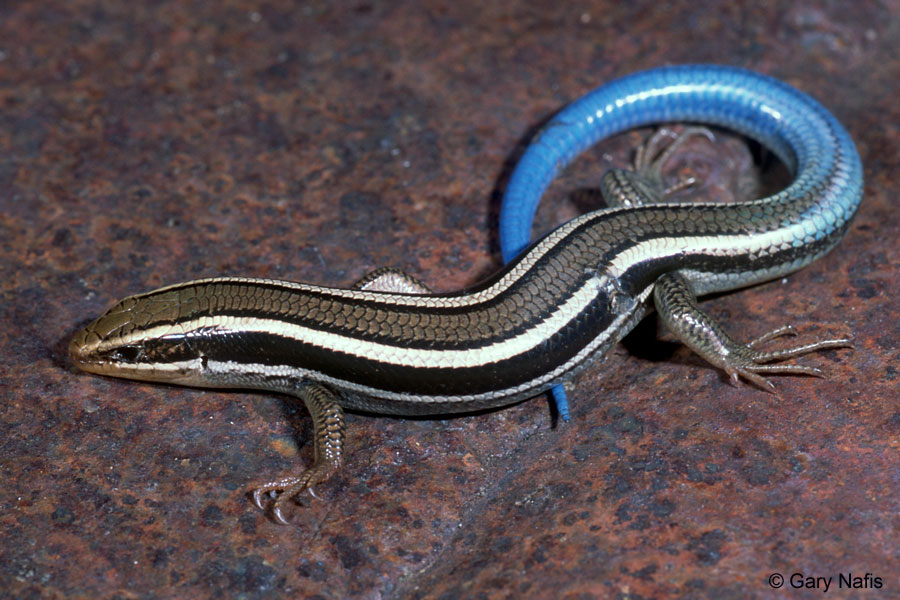 |
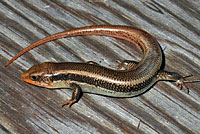 |
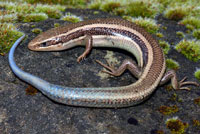 |
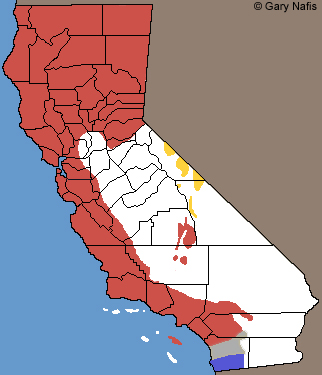 Range shown in Red and Gray |
|||||
| Adults are about 2 - 3 inches long, not including the tail. Typically 7.5 inches long with the tail. A small lizard with a slim body, a small head with a thick neck, small legs, and smooth shiny scales. Dark brown on the head and back with two light stripes on the edge of the back, dark stripes down the sides, and light strips on the edge of the belly. Juveniles have a bright blue tail that fades as they age. Old adults often have no blue on the tail. Adults develop red or orange coloring on the head and throat during the breeding season. |
Diurnal. Common but secretive and not often seen moving around. Found in grassland, woodlands, forests, sagebrush, chaparral, especially in rocky areas near streams and open sunny areas. Sometimes, when this lizard moves quickly through leaf litter or short grass, only the blue tail is seen, and this is often mistaken to be a small blue snake. |
Eats small bugs, including spiders and sow bugs. Females lay eggs in June and July which hatch in July and August. Typically found underneath rocks or other surface debris. |
|||||||
| California Whiptail Aspidoscelis tigris munda |
|||||||||
Video |
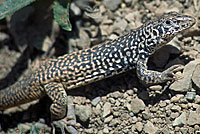 |
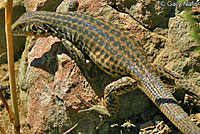 |
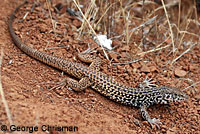 |
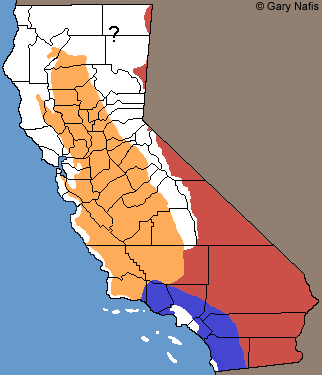 Range shown in Orange |
|||||
| © George Chrisman | |||||||||
 |
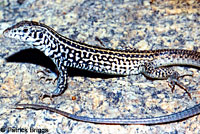 |
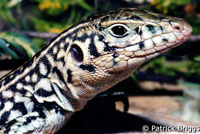 |
|||||||
| © Jackson Shedd | © Patrick Briggs | ||||||||
| Adults are about 3 to 5 inches long, not including the tail. A long slim lizard with a long thin tail, a thin snout, and large plates on the head. Gray, tan, or brown in color, with dark spots or bars on the back and sides that form 8 faint or indistinct brown stripes. The overall appearance when seen moving at a distance is of dark and light spots all over the body. Juveniles have distinct stripes and bright blue tails. |
Diurnal. Common and conspicuous, but not found in most of our area. Found in hot, dry, open areas with sparse vegetation, including woodland, chaparral, and riparian areas. |
Eats small bugs including spiders, scorpions, centipedes, and termites. Also known to eat small lizards. Females lay eggs from April to August. Very active, moving quickly on the ground with abrupt starts and stops. |
|||||||
| Mediterranean Gecko Hemidactylus turcicus Not Native to California |
|||||||||
Video |
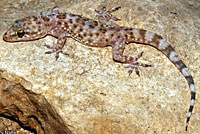 |
 |
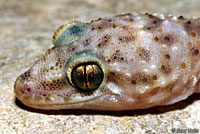 |
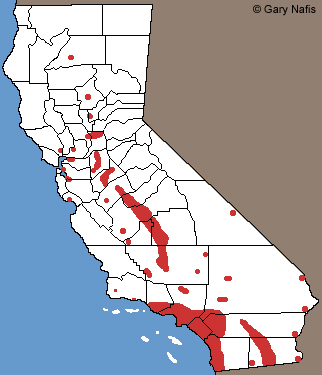 This lizard continues to expand its range in California. Red marks on the map indicate some of the areas where it has been found and could be established. |
|||||
| Gecko in light phase | Same gecko in dark phase | ||||||||
 |
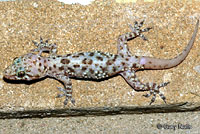 |
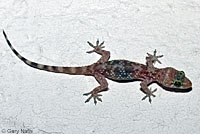 |
|||||||
| 1.75 to about 2.5 inches long, not including the tail. 4 to 5 inches long with the tail. A small, slightly flattened lizard with conspicuous large bumpy tubercles on the skin and large eyes with vertical pupils. Two color phases. Light phase is pale pinkish white with dark blotching and spotting sometimes forming indistinct bands. Dark phase is dark brown or gray with darker markings and bands. The tail is ringed with dark and light bands. |
Nocturnal. Rare in our area and a non-native species. Native to the Mediterranean region. Typically spread from place to place in shipments of goods and lumber. Found living in or near human dwellings, but probably also found in surrounding habitats. Recorded from a few locations in Southern California, but probably established in many more areas, and spreading. |
Eats a variety of small invertebrates. Females lay eggs from April to August. Typically seen on the outside wall of a building at night under a light, where they catch flying insects. May also be seen on walls indoors. |
|||||||
| Turtles | |||||||||
Most turtles in the San Francisco Bay Area are active during warm and sunny weather, typically from about late February through October, but sometimes they are active all year. |
|||||||||
| Southwestern Pond Turtle Actinemys pallida |
|||||||||
Video |
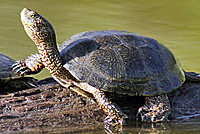 |
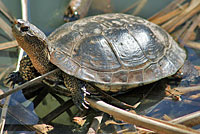 |
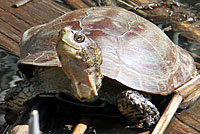 |
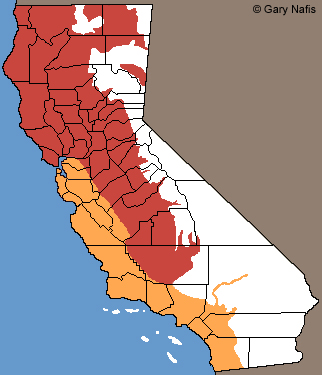 Range shown in Orange Range shown in Orange |
|||||
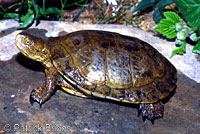 |
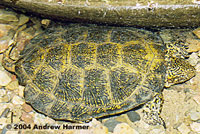 |
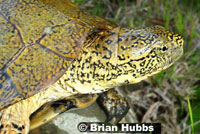 |
|||||||
| © Patrick Briggs | © Andrew Harmer | © Brian Hubbs | |||||||
| The shell is typically 3.5 to 8.5 inches long. Hatchlings are abut 1 inch long. A dark brown, olive, or black turtle with a low un-keeled shell, usually with a pattern of lines or spots radiating from the centers of the scutes. The head and neck are light in color with dark mottling. |
Diurnal. Common in some areas, but declining. Found in ponds, lakes, rivers, streams, creeks, marshes, and irrigation ditches with abundant vegetation in a variety of areas including woodland, forest, grassland, and parks. Rarely seen away from water. Often seen basking just above the water |
Eats aquatic plants, bugs, worms, frog eggs and tadpoles, salamander eggs and larvae, crayfish, carrion, and occasionally frogs and fish. Females crawl onto land and lay eggs between April and August. |
|||||||
| Green Sea Turtle Chelonia mydas |
|||||||||
Video |
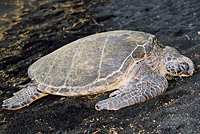 |
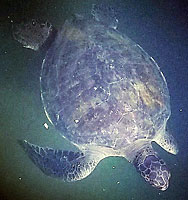 |
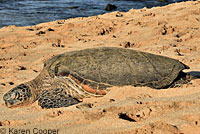 |
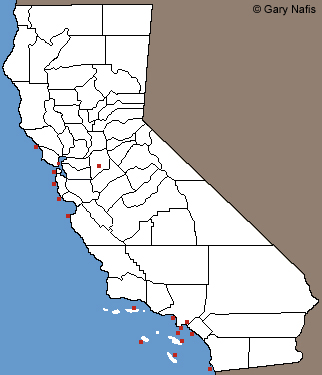 Locations where Green Sea Turtles have been recorded are shown in Red. |
|||||
| © Karen Cooper | |||||||||
| The shell is 30 to over 60 inches long. A large sea turtle with powerful paddle-like forelimbs and a broad, low, smooth, heart-shaped shell. The shell is green, olive, brown, gray, or black, sometimes with a mottled or radiating pattern. Green fat, not body coloring, gives this turtle its name. |
Diurnal. Rare in our area. Only occasionally seen off the coast. Found in the ocean, feeding in lagoons, bays, estuaries, eelgrass and seaweed beds where there is abundant aquatic vegetation in shallow protected water. Mostly aquatic, rarely coming onto land. |
Eats seaweed, algae, and marine invertebrates including sponges and jellyfish. Females crawl onto sandy shores and lay eggs any time between February and January depending on the location. Young hatch at night and immediately crawl into the ocean. |
|||||||
| Olive Ridley Sea Turtle Lepidochelys olivacea |
|||||||||
Video |
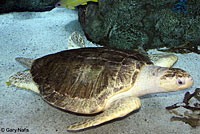 |
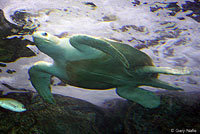 |
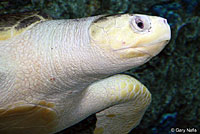 |
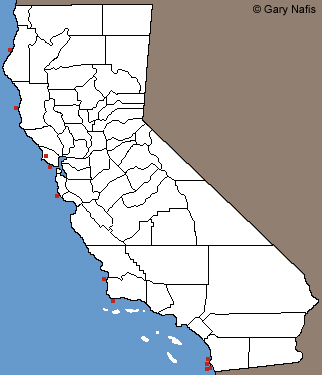 Locations where Olive Ridley Sea Turtles have been recorded are shown in Red Locations where Olive Ridley Sea Turtles have been recorded are shown in Red |
|||||
| The smallest sea turtle. Adults are 20 to 29 inches in length. A small sea turtle with a round, flat shell, a large triangular head, and large paddle-like limbs. The shell is olive to grayish green and the skin is gray. |
Rare in our area. Pelagic, found in open ocean and in bays, lagoons, and shallow waters offshore. |
Mostly carnivorous. Eats mollusks, crustaceans, jellyfish, sea urchins, crab, fish, sea urchins, snails, jellyfish, and occasional plant material - algae, seagrass, and seaweed. Females lay eggs on sandy beaches. Eggs hatch in 45 to 70 days. Hatchlings dig to the surface and immediately crawl into the ocean. |
|||||||
| Leatherback Sea Turtle Dermochelys coriacea |
|||||||||
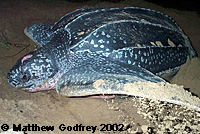 |
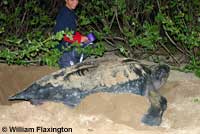 |
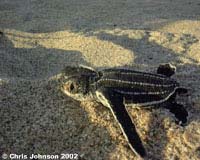 |
 Locations where Leatherback Sea Turtles have been recorded are shown in Red Locations where Leatherback Sea Turtles have been recorded are shown in Red |
||||||
| © Matthew Godfrey | © William Flaxington. | © Chris Johnson | |||||||
| The largest turtle on Earth, averaging 48 to 96 inches in shell length, and weighing 600 to 1,600 lbs. A huge sea turtle with smooth leathery skin, a large head, and large paddle-like limbs. Dark brown, slate, or blue-black, sometimes with pale blotches. |
Rare - occasionally found along the coast. Pelagic, living in the open ocean, occasionally entering bays and estuaries. |
Eats mostly jellyfish, along with some marine plants, and marine invertebrates and vertebrates, including sea urchins, snails, octopi, squid, crabs, and small fish. Females lay eggs on sandy beaches. Eggs hatch in 60 to 65 days. Hatchlings dig to the surface and crawl immediately into the ocean. Those found in California waters have been found to nest across the entire Pacific ocean in Indonesia, New Guinea, and the Solomon Islands. |
|||||||
| Red-eared Slider Trachemys scripta elegans Not Native to California |
|||||||||
Video |
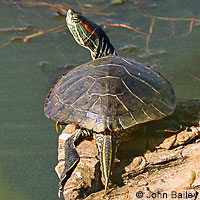 |
 |
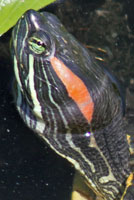 |
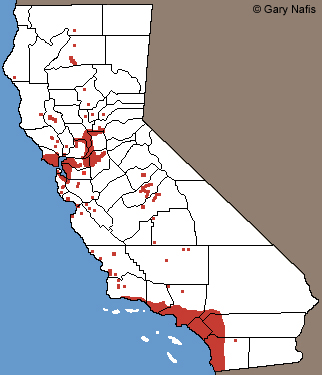 Range shown in Red |
|||||
| © John Bailey | |||||||||
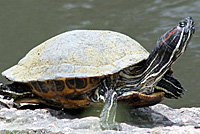 |
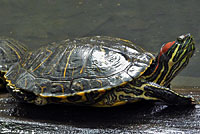 |
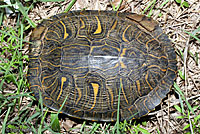 |
|||||||
| The shell is 3.5 to 14.5 inches long. The shell is olive, brown, or black in color with streaks and bars of yellow or eye-like spots. The skin is green to olive brown with yellow markings and a prominent broad red stripe behind the eye. |
Diurnal. Common, but not native. Found in sluggish rivers, ponds, shallow streams, marshes, lakes, reservoirs, and urban park ponds. |
Females crawl onto land and lay eggs between April and July. Eats crustaceans, mollusks, fish, insects, snails, tadpoles, and aquatic plants. May be active on sunny days in winter. |
|||||||
| Yellow-bellied Slider Trachemys scripta scripta Not Native to California Please email me if you see this species in the wild in California, and send pictures if you can. |
|||||||||
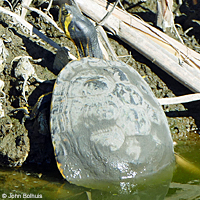 |
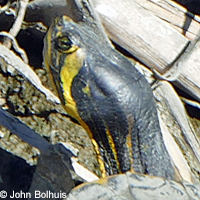 |
 |
 Range shown in Red Range shown in Red |
||||||
| © John Bolhuis | |||||||||
| A medium to large freshwater turtle. Related to the much more numberous Red-eared Slider. The carapace is black and brown often with yellow stripes. Skin is olive green with patches of yellow on the legs and neck. The backs of the hind limbs are marked with vertical yellow stripes and the front of the forlimbs are marked with narrow yellow stripes. The name is derived from the yellow plastron (underside) which has round dark markings on the edges. Adults tend to grow darker in color as they get older.. |
Diurnal Semi-aquatic, spending much time in bodies of water, but also travels overland during dry seasons to locate a new water source and during the breeding season to find mates. Females also move overland to find a site to lay eggs. Tolerant of fairly dirty and even brackish water. Feeds mostly in the morning before basking on logs, shorelines, or while floating. Sleeps at night on the water bottom or on the surface near surface vegetation to hide under such as brush piles or mats of algae. Basks out of the water on banks, rocks, logs, or other exposed objects, often in large groups, and sometimes stacked one upon another. |
Omnivorous, eating leaves, roots, fruits, and stems of aquatic plants, aquatic invertebrates, snails, insects, crustaceans, mollusks, and vertebrates including fish, frogs, and tadpoles. Hatchlings are primarily carnivorous, but consume progressively larger amounts of vegetation as they mature. As they grow older, adults eat less meat, with most of their diet consisting of plants. Found in a wide variety of habitats in its native range, mostly in calm fresh water areas with abundant aquatic vegetation, such as sluggish rivers, ponds, shallow streams, marshes, lakes, and reservoirs. Also been known to tolerate the brackish waters and survive in coastal waterways. Found in similar habitat in California, mostly in areas with heavily-populated areas. |
|||||||
| Western Painted Turtle Chrysemys picta bellii Not Native to California Please email me if you see this species in the wild in California, and send pictures if you can. |
|||||||||
Video |
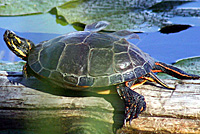 |
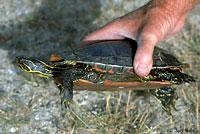 |
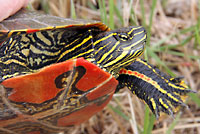 |
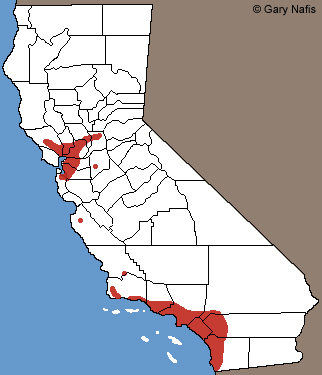 Range shown in Red |
|||||
| 2.5 to 10 inches long. A small turtle with red markings on the bottom and no red markings on the sides of the head. The shell is black, brown, or olive in color with a network of faint light lines, and olive, yellow, or red borders on the shields. The head and limbs are olive or black with yellow lines. |
Diurnal. Uncommon. The most widespread species of turtle in North America, but not native to California. Aquatic. Found in ponds, marshes, lakes, ditches, and quiet streams. |
Eats almost anything it can find, including insects, worms, snails, crayfish, fish, amphibians and tadpoles, carrion, and aquatic vegetation. Females lay eggs on land between May and August. |
|||||||
| Snapping Turtle Chelydra serpentina Not Native to California Please email me if you see this species in the wild in California, and send pictures if you can. |
|||||||||
Video |
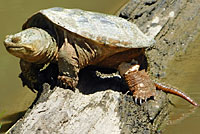 |
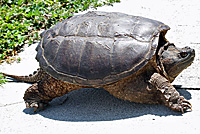 |
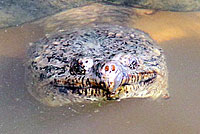 |

Red dots = Some locations of Snapping Turtle sightings in California |
|||||
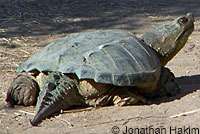 |
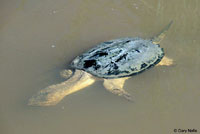 |
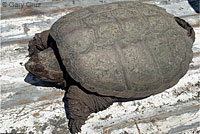 |
|||||||
| © Jonathan Hakim | © Gary Cruz | ||||||||
| 8 - 18.5 inches in shell length A large freshwater turtle with a massive head with huge hooked jaws, a long tail, a saw-toothed crest, and a shell that looks like it is too small to fit the body. The legs are large with webbed toes and heavy claws. The tail is longer than half the length of the carapace. Average weight is around 45 lbs, but some captives have weighed in at over 75 lbs. The skin is gray, black, yellow, or tan, with tubercles on the neck. White flecks occur on some individuals. |
The color of the shell ranges from black, brown, or olive to tan. The shell is often covered with mud or algae, which helps camouflage the turtle. The shell is heavily serrated on the rear edge, and scutes may have a pattern of radiating lines. Active most of the year, becoming dormant in areas with cold winters, generally in late October. Remains dormant either burrowed into the mud bottom, or under overhanging banks, root snags, stumps, brush, logs, or other debris. Aquatic, found in or near water. An excellent swimmer. |
Sometimes seen basking on or under the surface in shallow water. Often rests buried in the mud with its eyes and nostrils exposed in water shallow enough that it can raise its long neck up to allow the nostrils to break the surface and breathe without moving out of the mud. Females crawl onto land, sometimes traveling over great distances, to dig a nest where they lay a clutch of eggs. Egg laying takes place mostly in June and July (but can occur any time between May and October). The eggs hatch in 9 - 18 weeks. |
|||||||
| Texas Spiny Softshell Apalone spinifera emoryi Not Native to California |
|||||||||
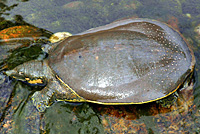 |
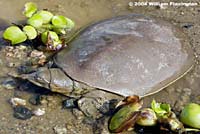 |
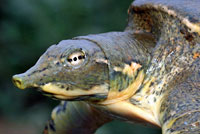 |
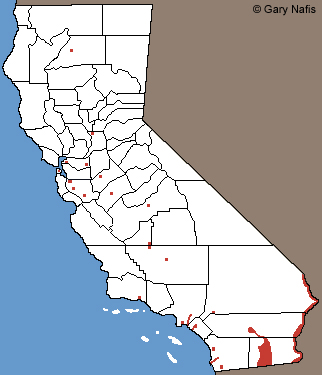 Range shown in Red |
||||||
| The shell is 5 to 21 inches long. A flat turtle with a rounded, leathery shell without visible scutes and a long snout with open nostrils on the end. The shell is olive, brown, or gray in color, sometimes with dark markings that fade with age. The head and limbs are olive to gray with dark markings and two light stripes mark each side of the head. |
Diurnal. Rare and not native to our area. Found in permanent rivers, agricultural canals, drainage ditches, artificial lakes, and ponds. |
Eats insects, crayfish, worms, snails, fish, frogs, and tadpoles. Females crawl onto land and lay eggs between May and August that hatch between August and September. |
|||||||
| River Cooter Pseudemys concinna Not Native to California |
|||||||||
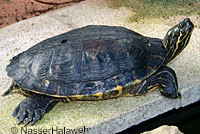 |
 |
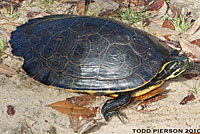 |
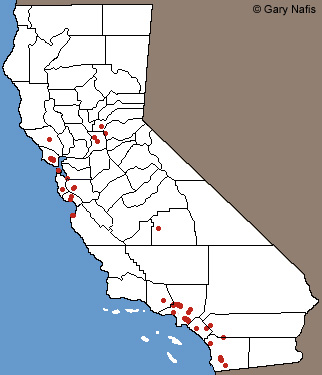 Red: Some locations where this species has been reported. |
||||||
| Adult Eastern River Cooter, Hannover Germany © NasserHalaweh 2010 Used under license CC BY-SA 4.0 (Copyright was added. Image was cropped for close-up and thumbnails.) |
Adult, Georgia © Todd Pierson 2011 Used under license CC BU-NC 3.0. (Image was cropped and re-sized for thumbnail.) |
||||||||
A large mostly-aquatic freshwater diurnal turtle found in rivers, lakes, and ponds. Typically observed when basking on rocks, logs, or shores.
|
Diurnal Typically seen basking in the sun on logs and rocks, often with other aquatic turtles. Quickly slips into the water when disturbed. Found in artificial lakes and ponds in California. Inhabits rivers with strong currents in its native range. |
In California, observed mainly in densely-populated areas in the S.F. Bay Area, the Los Angeles Basin, the Sacramento area, and in San Diego County, the result of illegally released unwanted pets. It is not known yet if it has been established and breeding in any location other than at Otay Lake in San Diego County. Due to its shy behavior that makes it difficult to observe, probably found in many more locations. |
|||||||
| Frogs and Toads | |||||||||
Frogs and toads in the San Francisco Bay Area can be active most of the year, except during very hot and very cold weather. However, even during hot and dry weather, some species can be seen floating in water. |
|||||||||
| Sierran Treefrog Pseudacris sierra (formerly Hyla regilla - Pacific Treefrog) |
|||||||||
Call Video |
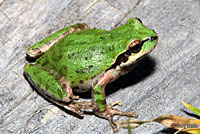 |
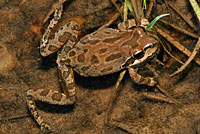 |
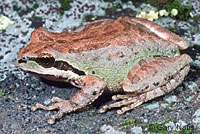 |
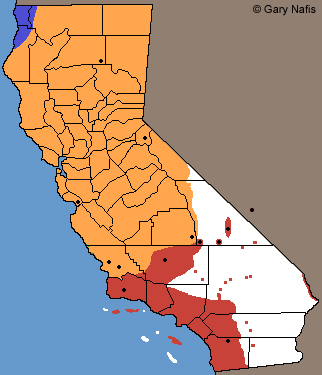 Range shown in Orange |
|||||
| Adult frogs are 3/4 to 2 inches long. A small frog with smooth skin, a large head and eyes, round pads on the toe tips, and a wide dark stripe through the middle of each eye. Most frogs are green or brown in color overlaid with irregular dark markings, but some frogs are, gray, reddish, or cream in color. |
Diurnal and Nocturnal. The most commonly seen frog in our area. If you hear frogs calling at night, it is usually this species. Found almost anywhere there is water for breeding, including forest, woodland, chaparral, grassland, pastures, streams, and urban areas. |
Eats a wide variety of invertebrates, including flying insects. Females lay eggs in water some time between November and July. Eggs hatch into tadpoles in 2 to 3 weeks. The tadpoles live in water then transform into tiny frogs and move onto land 2 to 2.5 months later. Active most of the year except during extreme cold and extreme heat when it stays in moist shelters. |
|||||||
| California Toad Anaxyrus boreas halophilus (formerly Bufo boreas halophilus) |
|||||||||
Call Video |
 |
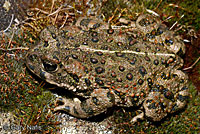 |
 |
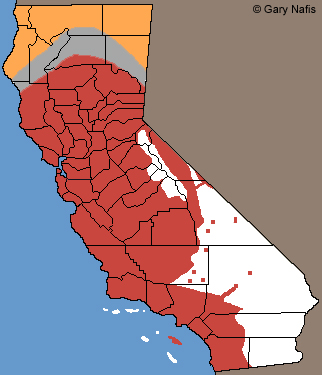 Range shown in Red and Gray |
|||||
| Adults are 2 to 5 inches long. A large squat toad with dry warty skin. Color is greenish, tan, reddish brown, gray, or yellowish with irregular dark blotches and a light-colored stripe down the middle of the back. Warts on the back are often on dark blotches. |
Diurnal in cool weather, Nocturnal in hotter weather. Common where found but less common in urbanized areas. Found in a variety of areas including marshes, springs, creeks, ponds, small lakes in woodland, forest, and grassland. The only species of toad found in our area. |
Eats a wide variety of invertebrates. Females lay eggs in water some time between January and July, depending on the location, rainfall, and snowmelt. Eggs hatch into tadpoles in about a week or two. Tadpoles live in the water then transform into tiny toads and move onto land in about 1 to 1.5 months. Active mostly late Winter through Fall except during extreme cold and extreme heat when it stays in moist shelters. |
|||||||
| California Red-legged Frog Rana draytonii |
|||||||||
Call Video |
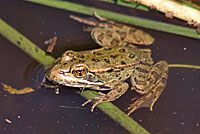 |
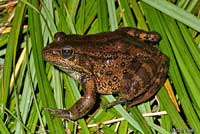 |
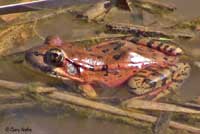 |
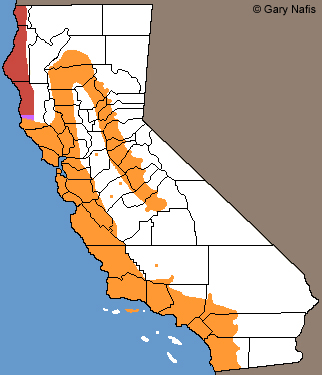 Range shown in Orange and Purple |
|||||
| Adults are about 2 - 5 inches long. A medium-sized frog with smooth skin and a visible line on the sides of the back and a wide dark marking behind each eye. Reddish-brown, brown, gray, or olive in color with small black flecks and spots on the back and sides and dark bands on the legs. Red coloring underneath the rear legs. |
Diurnal and Nocturnal. Common where it occurs, declining due to loss of habitat due to development. Found mainly in and near ponds in a variety of habitats, including forest, woodland, grassland, coastal scrub, and streamsides, but sometimes found far away from water. |
Eats a variety of invertebrates, and occasionally small vertebrates such as fish, mice, frogs, and salamander larvae. Females lay eggs in water some time from November to April depending on the location. Eggs hatch into tadpoles in about a month. Tadpoles live in the water then transform into tiny frogs and move onto land 4 to 6 months later, or sometimes not until the following summer. Mostly active late Winter through Fall. |
|||||||
| American Bullfrog Lithobates catesbeianus (formerly Rana catesbeiana) Not Native to Calfornia |
|||||||||
Call Video |
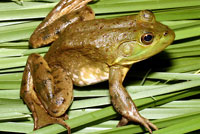 |
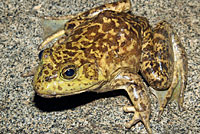 |
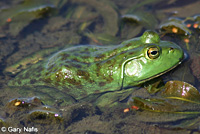 |
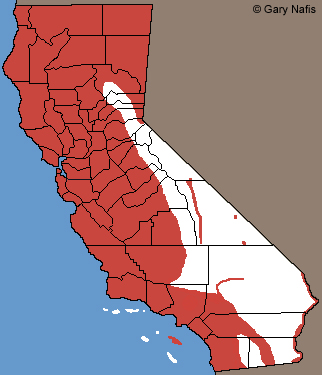 Range shown in Red |
|||||
| Adults are 3.5 to 8 inches long. The largest frog found in our area. A large frog with smooth skin and no lines on the sides of the back, and conspicuous eardrums. Light green to dark olive green in color with irregular dark spots and blotches. Juveniles have many small dark spots. |
Diurnal and Nocturnal. Common, but not native to our area. Found in permanent water - lakes, ponds, sloughs, reservoirs, marshes, slow rivers, irrigation canals, cattle tanks, and slow creeks, in almost any habitat which is open and sunny, including grassland, farmland, prairies, woodland, forests, and chaparral. |
Eats anything it can swallow, including invertebrates, mammals, birds, fish, reptiles, and amphibians. Females lay eggs in water typically between May and August. Eggs hatch into tadpoles 3 to 5 days. Tadpoles live in water and grow very large, not turning into small frogs and moving onto land until anytime between a few months and a year to two years. Mostly active late Winter through Fall. |
|||||||
| Foothill Yellow-legged Frog Rana boylii |
|||||||||
Call Video |
 |
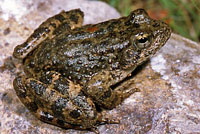 |
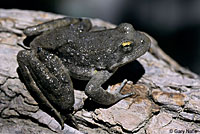 |
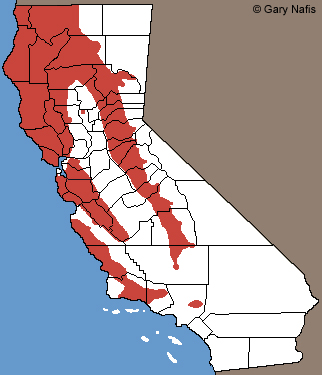 Range shown in Red |
|||||
| Adults are 1.5 to about 3 inches long. A small frog with bumpy skin and no dark markings between or behind the eyes and a faint light mark across the top of the head. Color is gray, brown, or olive, and either plain or with irregular dark mottling. Yellow under the rear legs. |
Diurnal and sometimes nocturnal. Rare: gone from most of its former range in our area, but still present in some outlying areas. Found in rocky streams and rivers with open, sunny banks, in forest, woodland, and chaparral. |
Eats a wide variety of aquatic, flying, and terrestrial invertebrates, including spiders, snails, and grasshoppers. Females lay eggs in still water of creeks and rivers from April to July, depending on when the water flow has slowed down sufficiently. Eggs hatch into tadpoles in about a week to 5 weeks. Tadpoles live in water then transform into tiny frogs and move onto land 3 to 4 months. Mostly active late Winter through Fall. |
|||||||
| Western Spadefoot Spea hammondii |
|||||||||
Call |
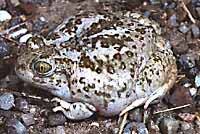 |
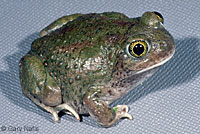 |
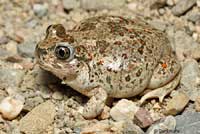 |
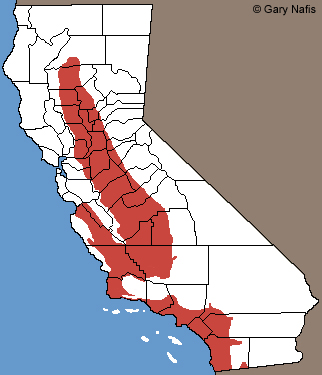 Range shown in Red |
|||||
| Adults are 1.5 to 2.5 inches long. A fat squat spadefoot with large eyes with vertical pupils. Color is greenish, brown, gray, or cream. Typically there are reddish spots, dark markings and 4 irregular light stripes on the back. |
Nocturnal. Uncommon and rarely seen. Spends most of its life underground. Found in open areas with sandy or gravelly soils in various habitats, including mixed woodlands, grasslands, coastal sage, chaparral. Found in the East Bay and South Bay only. |
Eats a variety of invertebrates, including beetles, moths, crickets, flies, ants, and earthworms. Females lay eggs in water some time between January and May after heavy rainfall creates temporary pools of water. Eggs hatch into tadpoles in about 3 to 6 days. Tadpoles live in water then transform into tiny spadefoots and move onto land in 4 to 11 weeks, depending on how long it takes for the pool to dry up. Surface active only during rains, typically January to May in our area. |
|||||||
| African Clawed Frog Xenopus laevis Not Native to California |
|||||||||
Call |
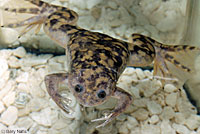 |
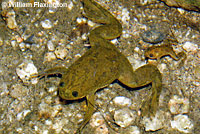 |
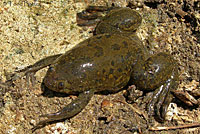 |
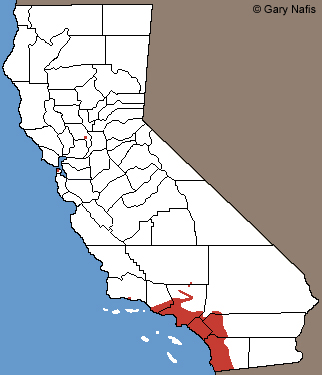 Range shown in Red |
|||||
| Adults are 2 to almost 6 inches long. A medium-sized frog with smooth skin, a flattened body, and a small head with a blunt snout and upturned eyes with no lids. Olive to brown in color with irregular dark markings. Rarely leaves water, but will move overland on rainy nights when ponds dry up. |
Nocturnal and diurnal. |
Eats anything it can catch, including aquatic invertebrates, fish, and amphibians and amphibian larvae. Females lay eggs in water any time between January and November, mostly in April and May. Eggs hatch into tadpoles in 2 or 3 days. Tadpoles live in water and transform into tiny frogs in 2.5 to 3 months or more. |
|||||||
| Salamanders | |||||||||
Most salamanders in the San Francisco Bay Area are active on the surface only during the rainy season, typically October or November to May, and remain underground at other times. Salamander larvae remain active in water throughout the summer. They are most often seen in moist areas underneath objects on the ground. |
|||||||||
| California Slender Salamander Batrachoseps attenuatus |
|||||||||
Video |
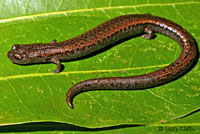 |
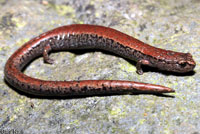 |
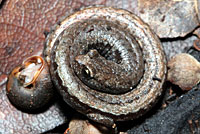 |
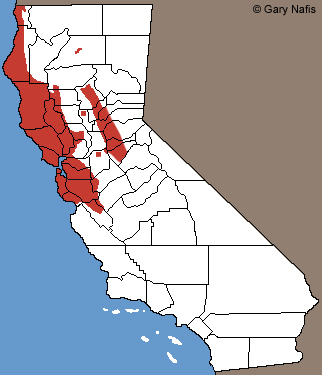 Range shown in Red |
|||||
Adults are about 3 to 5.5 inches long, including the tail. A tiny slender salamander with tiny legs that are not easily seen, making it look much like a worm. Color is dark brown or black with a wide red, brown, yellow, or tan colored stripe on the back with a herringbone pattern. |
Nocturnal. Common but secretive. Probably the most common salamander in our area. Often found underneath surface objects in yards and gardens in suburban and urban areas. Found in moist locations in a wide variety of locations, including chaparral, woodland, grassland, forests, urban yards, vacant lots, marshes, and beach driftwood. |
Eats a variety of small invertebrates, including springtails, small beetles, snails, mites, spiders, and isopods. Females lay eggs in moist terrestrial places in October and November. Young emerge from the eggs fully formed in about 2.5 to 3 months. Typically seen under rocks, logs, or other surface debris, but also found under garden vegetation, and sometimes seen crawling across wet sidewalks on rainy days and nights. |
|||||||
| Arboreal Salamander Aneides lugubris |
|||||||||
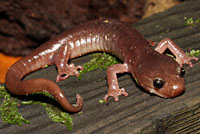 |
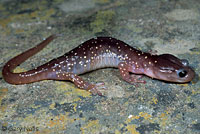 |
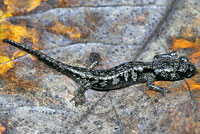 |
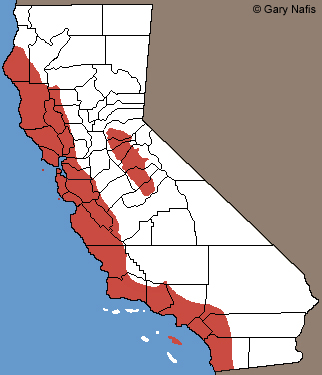 Range shown in Red |
||||||
| Adults are about 2 to 4 inches long not including the tail, which can be up to 3 inches long. A medium-sized salamander with a large head and a tail that is often coiled. Adults are brown with small cream to yellow spots on the body that can be tiny or large in size, and dense or sparse. Young are black with light speckles. |
Nocturnal. Common but secretive. Found in moist places on land, mostly in oak woodlands, but also coastal dunes, forests, and urban areas. Often found in yards and gardens in suburban and urban areas. |
Eats a variety of small invertebrates, including millipedes, worms, snails, ants, termites, sow bugs, moths, and centipedes, and sometimes small salamanders. Females lay eggs in moist terrestrial places in late spring and early summer. Young hatch fully-formed in August and September. |
|||||||
| Oregon Ensatina Ensatina eschscholtzii oregonensis |
|||||||||
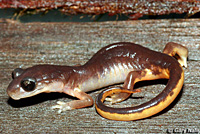 |
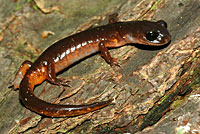 |
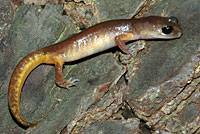 |
 Range shown in Red |
||||||
| Adults are 1.5 - 3.2 inches long not including the tail, up to 6 inches long with the tail. A medium-sized salamander with smooth skin, dark eyes sometimes with a faint yellow patch on top, a tail that is constricted at the base, and visible grooves on the sides between the legs. Orange or brown in color with lighter orange marking the upper eyelids, tail, sides of the head, and base of the limbs. Young have many light speckles on the body. |
Nocturnal. Common. Found in moist shaded areas in forests, oak woodlands, mixed grassland, and chaparral. |
Eats a wide variety of invertebrates, including spiders, beetles, crickets, sow bugs, centipedes, millipedes, worms, snails, and termites. Females lay eggs in moist terrestrial places typically in April and May. Young hatch fully-formed, probably in the fall. Typically seen under rocks, logs, or other surface debris, but sometimes seen crossing roads on rainy nights. |
|||||||
| Yellow-eyed Ensatina Ensatina eschscholtzii xanthoptica |
|||||||||
 |
 |
 |
 Range shown in Yellow |
||||||
| Adults are 1.5 - 3.2 inches long not including the tail, up to 6 inches long with the tail. A medium-sized salamander with smooth skin, dark eyes with a yellow patch on top, a tail that is constricted at the base, and visible grooves on the sides between the legs. Orange or brown in color with lighter orange marking the upper eyelids, tail, sides of the head, and base of the limbs. Young have many light speckles on the body. |
Nocturnal. Common. Found in moist shaded areas in forests, oak woodlands, mixed grassland, and chaparral. |
Eats a wide variety of invertebrates, including spiders, beetles, crickets, sow bugs, centipedes, millipedes, worms, snails, and termites. Females lay eggs in moist terrestrial places typically in April and May. Young hatch fully-formed, probably in the fall. Typically seen under rocks, logs, or other surface debris, but sometimes seen crossing roads on rainy nights. |
|||||||
| California Newt Taricha torosa |
|||||||||
| Poisonous - Very Dangerous if Eaten | |||||||||
Video |
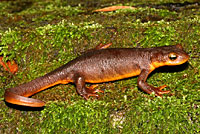 |
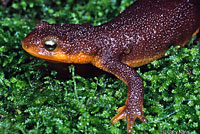 |
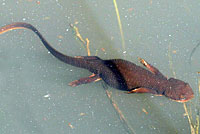 |
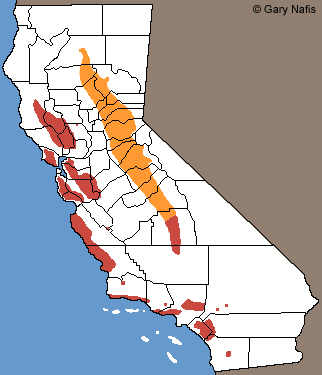 Range shown in Red |
|||||
| Adults are about 3 to 3.5 inches long, not including the tail, and up to 8 inches with the tail. A stocky, medium-sized salamander with rough skin, no grooves on the sides between the legs, and dark eyes with a yellow patch on top. When living in the water during the breeding season, the skin becomes smooth and the tail is wider. Brown above, and pale orange or yellow below and on the head below the eyes. |
Diurnal. Common. Found in wet forests, woodlands, chaparral, and grasslands. |
Eats a variety of small invertebrates, including worms, snails, slugs, sow bugs, and insects, along with amphibian eggs and larvae, and sometimes small vertebrates. Females lay eggs in water between December and April, depending on location and habitat. Eggs hatch into larvae in 2 to 7 weeks. Larvae live in the water then transform into tiny newts and move onto land in several months. Often seen crawling on the ground in daylight during wet weather. |
|||||||
| Rough-skinned Newt Taricha granulosa |
|||||||||
| Poisonous - Very Dangerous if Eaten | |||||||||
Video |
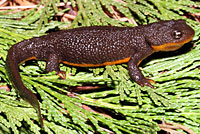 |
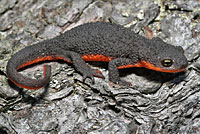 |
 |
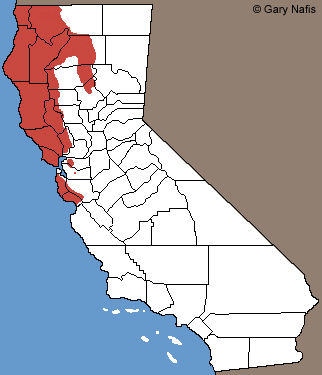 Range shown in Red |
|||||
| Adults are 2.5 to 3.5 inches long, not including the tail, and up to 8 inches with the tail. A stocky, medium-sized salamander with rough skin, no grooves on the sides between the legs, and dark eyes with a yellow patch on top. When living in the water during the breeding season, the skin becomes smooth and the tail is wider. Brown above, and yellow or orange below. |
Diurnal. Common. Found in grassland, woodland, and coniferous forest near ponds, lakes, streams and creeks that are used for breeding. |
Eats a variety of small invertebrates, salamander and frog eggs, and tiny fish. Females lay eggs in water during late winter and spring in our area. Eggs hatch into larvae in about 3 weeks. Larvae turn into tiny newts and crawl onto land in about 4 or 5 months. Often seen crawling on the ground in daylight during wet weather. |
|||||||
| Red-bellied Newt Taricha rivularis |
|||||||||
| Poisonous - Very Dangerous if Eaten | |||||||||
Video |
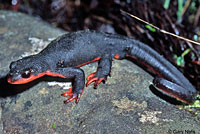 |
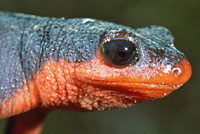 |
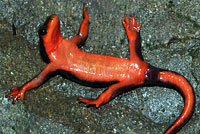 |
 Range shown in Red |
|||||
| Adults are 2 3/4 - 3 1/2 inches long (7 - 8.9 cm) from snout to vent, and 5 1/2 - 7 1/2 inches (14 - 19.5 cm) in total length. A stocky, medium-sized salamander with rough skin, no grooves on the sides between the legs, and dark eyes. (This species of newt has no yellow patch in the eye.) When living in the water during the breeding season, the skin becomes smooth and the tail is wider. Dark brown to black above, and reddish below. |
Diurnal. Very uncommon with an extremely limited range in the Bay Area: An isolated population has been discovered in the Stevens Creek watershed in Santa Clara County, more than 80 miles (130 km) south of the former known range of the species. Researchers have not been able to determine if the population is natural or introduced. |
Eats a variety of small invertebrates. Females lay eggs in water during late winter and spring. Eggs hatch into larvae in 3-4 weeks. Larvae turn into tiny newts and crawl onto land in about 4 to 6 months. Often seen crawling on the ground in daylight during wet weather. |
|||||||
| California Giant Salamander Dicamptodon ensatus |
|||||||||
Video |
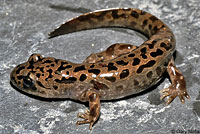 |
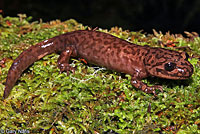 |
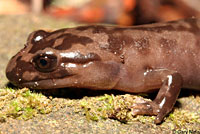 |
 Range shown in Red |
|||||
| Adults are 2.5 to almost 7 inches long not including the tail, and up to 12 inches with the tail. A large robust salamander with smooth skin, a massive head and stout limbs. Reddish brown overlaid with copper-colored marbling. |
Nocturnal and also diurnal in wet overcast conditions. Common but secretive. Found in wet coastal forests in or near clear, cold, permanent and semi-permanent streams and seepages. Also found in a network of caves near Santa Cruz. |
Eats anything it can overpower and eat, including slugs, invertebrates, salamanders, rodents, and lizards. Females lay eggs in water that take about 5 months to hatch. Larvae live in water and transform into tiny salamanders and move onto land in about 18 months. Adults are typically seen underneath rocks or logs, but sometimes seen crossing roads on rainy nights or on the ground in suburban yards at night. |
|||||||
| Santa Cruz Black Salamander Aneides niger |
|||||||||
 |
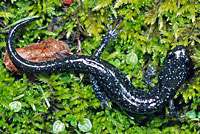 |
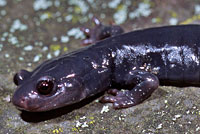 |
 Range shown in Dark Blue |
||||||
| Adults are 2 to almost 4 inches long, not including the tail, and up to 5.5 inches long with the tail. A medium-sized salamander with smooth skin, and visible grooves on the sides between the legs. Black in color with a few fine white specks. Young have more light speckling than adults. |
Nocturnal. Uncommon. Found in mixed woodland, forests, and grasslands. Found on the Southern Peninsula and in the Santa Cruz Mountains only |
Eats small invertebrates, including insects, millipedes, ants, and termites. Females lay eggs in moist terrestrial places in July and August. Young hatch fully-formed. Adults are typically seen underneath rocks or logs. |
|||||||
| California Tiger Salamander Ambystoma californiense |
|||||||||
Video |
 |
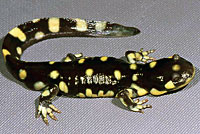 |
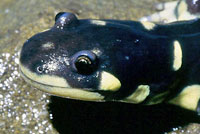 |
 Range shown in Red |
|||||
| Adults are 3 to 5 inches long, not including the tail, and up to 8.5 inches with the tail. A large salamander with smooth skin, and a large wide head with small eyes. Shiny black with large yellow spots and bars on the back and sides. |
Nocturnal. Secretive and rarely seen. Found in grassland, oak savanna, and at the edges of mixed woodland, where there is access to temporary breeding pools. Surface active only during the rainy season, typically November to May, hiding underground at other times. |
Eats a variety of invertebrates. Females lay eggs in water from November to May after rainfall has created temporary breeding pools. Eggs hatch in 2 to 4 weeks. Larvae live in water for 4 to 5 months before transforming into tiny salamanders and moving onto land. Typically seen crossing roads on rainy nights in winter. |
|||||||
Return to the Top
© 2000 -
